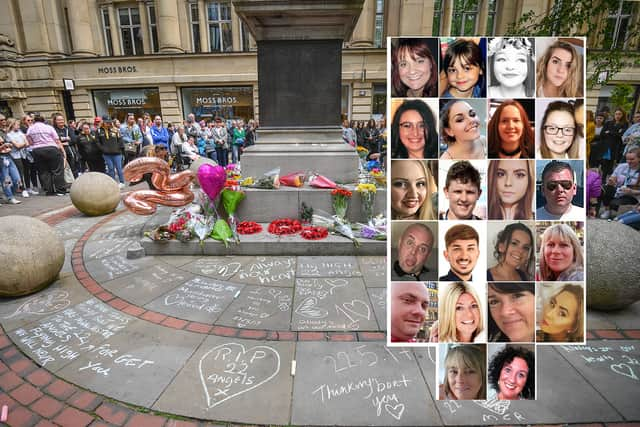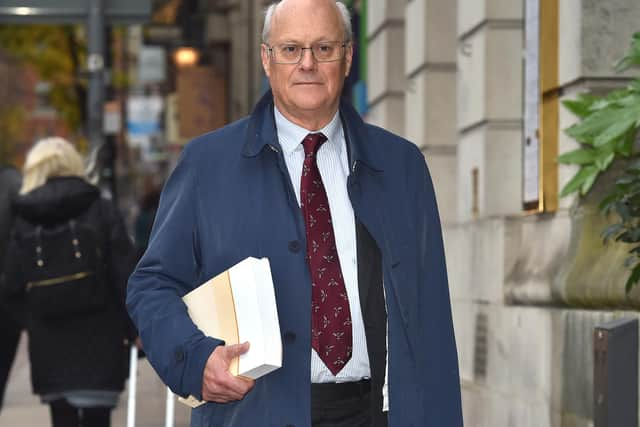Manchester Arena Inquiry: what were the findings of report by Sir John Saunders into bombing
and live on Freeview channel 276
Manchester Arena bombing victim John Atkinson, 28, would probably have survived but for inadequacies in the emergency response, the Manchester Arena Inquiry has found. The chairman of the inquiry said in his report he had been “highly critical” of elements of the rescue operation, and there were “significant failings” by organisations in their preparations and training for such an attack, and on the night itself.
Twenty-two people were killed and hundreds were injured in a suicide attack at the end of an Ariana Grande concert on 22 May, 2017. Thursday’s report by Manchester Arena Inquiry chairman Sir John Saunders will also focus on the experience on the fateful night of each of those who died.
Advertisement
Hide AdAdvertisement
Hide AdHe said: “Those who have listened to the evidence will not be surprised that I am highly critical of many of the rescue operation. “Those criticisms must not overshadow our admiration for the courage of those who went into the City Room without any hesitation to help the dying and the injured.”
Evidence into the circumstances leading up to and surrounding the atrocity was heard in the city between 7 September, 2020 and 15 February this year. The hearings began and ended with a minute’s silence to remember those who died.
The photographs of those who died were displayed in the hearing room at Manchester Magistrates’ Court at the start of the public inquiry as their final movements were outlined – where they were when Salman Abedi, 22, detonated his bomb in the City Room foyer, the extent of the medical treatment given and the details of their injuries.
Sir John’s first report on security issues at the Arena was issued last June and highlighted a string of “missed opportunities” to identify Abedi as a threat before he walked across the City Room and detonated his shrapnel-laden device.


What happened to John Atkinson?
Advertisement
Hide AdAdvertisement
Hide AdCare worker John Atkinson, 28, was six metres away when the explosion went off in the City Room foyer of the venue at the end of an Ariana Grande concert on the evening of May 22, 2017.
A member of the public used his wife’s belt as a tourniquet on Mr Atkinson’s leg as he lay bleeding in agony on the City Room floor for up to 50 minutes, during which time he told a police officer: “I’m gonna die.”
Only three paramedics entered the City Room on the night and none were seen to attend or assist Mr Atkinson, before he was carried on a makeshift stretcher to a casualty clearing area where he later suffered a cardiac arrest – one hour and 16 minutes after the blast.
Sir John said: “In the case of John Atkinson, his injuries were survivable. Had he received the care and treatment he should have, it is likely he would have survived. It is likely that inadequacies in the emergency response prevented his survival.”
Advertisement
Hide AdAdvertisement
Hide AdHe said Mr Atkinson would probably have survived if an “intervention sufficient to slow substantially or stop bleeding” had been undertaken up to 45 minutes after the blast.
Staff at the Arena owner SMG’s then medical provider ETUK should have been able to apply medical tourniquets to both his legs, along with dressings to his wounds.
More paramedics in the City Room would likely have identified the need for urgent treatment and/or evacuation, he said, while more ambulances at the scene would also have meant quicker care.
Sir John said Mr Atkinson would probably have been also prioritised quicker for evacuation if firefighters had arrived when they should have.


What did Sir John say about the emergency response?
Advertisement
Hide AdAdvertisement
Hide AdThe Manchester Arena Inquiry chairman delivered a scathing report on the response of the emergency services. He said: “Significant aspects of the emergency response on 22nd May 2017 went wrong. This should not have happened.
“Some of what went wrong had serious and, in the case of John Atkinson, fatal consequences for those directly affected by the explosion.” He highlighted the key failings in his report as:
- A lack of communication between emergency responders, both through the act of physically co-locating at a single multi-agency RVP (rendezvous point) and via radio.
- A failure to have available either a multi-agency control room talk group or to set one up on the night. This would have allowed control rooms to speak to each other directly.
- Greater Manchester Police’s (GMP) force duty officer (FDO) Inspector Dale Sexton did not inform other emergency services of his declaration of Operation Plato, a pre-determined response to a marauding armed terrorist, or keep it under review.
- The FDO and others in GMP failed to consider zoning the scene, following the declaration of Operation Plato, in the early stages of the response.
- No forward command post, for senior officers to liaise, was set up. This was principally the responsibility of GMP, the inquiry found.
- Delays by North West Ambulance Service (NWAS) in getting ambulances and paramedics to the scene.
- Failure to send members of NWAS’s specialist Hazardous Area Response Team into the City Room foyer, the scene of the explosion, to assist with triage and life-saving intervention of casualties.
- Failure to send non-specialist paramedics into the City Room to assist with triage.
- A failure to get stretchers to the City Room to help evacuate the injured.
- Greater Manchester Fire and Rescue Service (GMFRS) did not arrive on scene and make any contribution in removing the injured that its officers could have done.
- Staff at North West Fire Control did not pass on important information to officers in GMFRS.
- No-one in a senior position at GMFRS took a grip of the situation during the critical period of the response.
As the post-attack “golden hour” ended, the emergency response had failed to achieve effective evacuation. Just after midnight there were still 36 casualties waiting to go to hospital, with the last casualty departing at 2.50am on 23 May. Sir John said: “To those who experienced it, this period of time will have seemed interminable. It must not happen again.”
He said the evidence was “conclusive” there was no possibility that 20 of the 22 victims could have survived the “murderous actions” of Salman Abedi, referred to sparingly by his initials in the 874-page report.
Could Saffie-Rose Roussos have survived her injuries?
Advertisement
Hide AdAdvertisement
Hide AdLawyers for eight-year-old Saffie-Rose Roussos had submitted during the inquiry that her injuries were potentially survivable. However, Sir John concluded: “In the case of Saffie-Rose Roussos, it is highly unlikely that she could have survived her injuries. There was only a remote possibility she could have survived with different treatment and care.
“I do not consider that the evidence enables me to say she had absolutely no chance of survival if the most comprehensive and advanced medical treatment had been initiated immediately after injury.
“I make clear what I am postulating is a remote possibility of survival. On the evidence that I have accepted, what happened to Saffie-Rose Roussos represents a terrible burden of injury. It is highly likely her death was inevitable even if the most comprehensive and advanced medical treatment had been initiated immediately after injury.”
Who were the victims of the Manchester Arena bombing?
- John Atkinson, 28
- Courtney Boyle, 19
- Kelly Brewster, 32
- Georgina Callander, 18
- Olivia Campbell-Hardy, 15
- Chloe Rutherford, 17
- Liam Curry, 19
- Wendy Fawell, 50
- Martyn Hett, 29
- Megan Hurley, 15
- Alison Howe, 44
- Nell Jones, 14
- Michelle Kiss, 45
- Angelika Klis, 39
- Marcin Klis, 42
- Sorrell Leczkowski, 14
- Lisa Lees, 43
- Eilidh MacLeod, 14
- Elaine McIver, 43
- Saffie-Rose Roussos, aged eight;
- Philip Tron, 32
- Jane Tweddle, 51
What have the victims familes said?
Nicola Brook, a solicitor from Broudie Jackson Canter who represents five of the victims’ families, including the family of Saffie-Rose Roussos, said: “This damning report reveals what the families knew all along, that all the organisations meant to protect their loved ones failed on an enormous and unfathomable scale.
Advertisement
Hide AdAdvertisement
Hide Ad“To compound the families’ pain, they were then forced to listen to denials, excuses and finger-pointing rather than admissions of the terrible mistakes made.
“So much distress could have been spared had Greater Manchester Police admitted its glaring failures from the start. Saffie’s parents Andrew and Lisa have pushed to get answers about what happened to their beautiful daughter over five and a half incredibly traumatic years.
“After initially believing the blast had killed Saffie instantly, the pain of that loss was compounded by learning that she had lived for over an hour.” She continued: “Even more distressing was learning that their little girl had asked if she was going to die, something no parent should have to hear.”
Following the publication of the report, the family of John Atkinson said: “It is now clear beyond any doubt that on the night of the bombing John was totally failed at every stage, both by the private medical providers at the Arena, ETUK and the emergency services.
Advertisement
Hide AdAdvertisement
Hide Ad“It is crystal clear that due to those failings, John died from injuries that he could and should have survived. As the report says, timely medical treatment to stop or slow John’s catastrophic bleeding and get him to hospital would have saved him.” They added: “He was left, dying, without his dignity, on the floor when it should have been obvious to medics that he needed to get straight to hospital.
“As we know from witnesses, John kept asking if he was going to die. John must have known that he was dying and the pain that causes us is too great to put into words. This should simply never have been allowed to happen.”
What were the recommendations in the report?
Sir John said in the case of any major event there is a “care gap” - the time between the event and medical assistance arriving. Sir John said in order to reduce that gap “suitable people” were needed on site at places such as the arena who would be able to give life saving treatment. He said this could be part of a protect duty.
Sir John said that he wanted to repeat his “encouragement” to the government to consider bringing in legislation for a protect duty for companies that operate large entertainment venues as soon as possible.
Advertisement
Hide AdAdvertisement
Hide AdHe went on to say that as well as police, fire fighters and others first on the scene should have those “necessary life saving skills”. He also said that members of the public who found themselves at the aftermath of any such event and choose to stay and help should have the opportunity to get training that could “enable them to do something which may save a life”.
He implementation in some of his recommendations may already be taking place.
Comment Guidelines
National World encourages reader discussion on our stories. User feedback, insights and back-and-forth exchanges add a rich layer of context to reporting. Please review our Community Guidelines before commenting.
